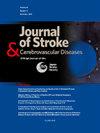From brain to heart: Causality and therapeutic potential in atrial fibrillation
IF 1.8
4区 医学
Q3 NEUROSCIENCES
Journal of Stroke & Cerebrovascular Diseases
Pub Date : 2025-07-08
DOI:10.1016/j.jstrokecerebrovasdis.2025.108394
引用次数: 0
Abstract
Objective
To elucidate the causal relationship between resting-state brain function and atrial fibrillation (AF), and to pinpoint potential genetic targets and therapeutic compounds for AF.
Methods
Employing GTEx V8 eQTL and deCODE Genetics pQTL datasets, key genes associated with AF were identified through Mendelian Randomization (MR) and Summary-based Mendelian Randomization (SMR) analyses. Colocalization analysis was subsequently conducted to confirm the shared genetic loci influencing both brain function and AF. In addition, transcriptome differential expression and pathway enrichment analysis were undertaken to delineate the potential molecular mechanism. Drug screening and molecular docking are employed to evaluate the therapeutic efficacy of the candidate compounds.
Results
MR Analysis revealed a significant causal relationship between resting-state brain functions of the default mode network (DMN) and central executive network (CEN) and AF. SMR and co-localization analyses identify the WIPF1 gene as a key genetic locus shared with brain function and AF. Candidate compounds C12H12N4S, C16H15N5O2 and C16H13NO6 showed anti-inflammatory and antibacterial properties, and exhibited good binding affinity in molecular docking, supporting their potential as therapeutic agents.
Conclusions
This study reveals a novel genetic association between resting-state brain function and AF and identifies WIPF1 as a potential therapeutic target, offering fresh insights into the study of brain-heart interaction and targeted treatment strategies for AF.
从脑到心:房颤的因果关系和治疗潜力
目的阐明静息状态脑功能与房颤(AF)的因果关系,寻找房颤潜在的遗传靶点和治疗药物。方法利用GTEx V8 eQTL和deCODE Genetics pQTL数据集,通过孟德尔随机化(MR)和基于摘要的孟德尔随机化(SMR)分析,鉴定房颤相关的关键基因。随后进行了共定位分析,以确认影响脑功能和房颤的共享遗传位点。此外,进行了转录组差异表达和途径富集分析,以描述潜在的分子机制。通过药物筛选和分子对接对候选化合物的治疗效果进行评价。结果SMR分析显示静息状态脑功能默认模式网络(DMN)和中央执行网络(CEN)与AF之间存在显著的因果关系,SMR和共定位分析发现WIPF1基因是与脑功能和AF共享的关键遗传位点。候选化合物C12H12N4S、C16H15N5O2和C16H13NO6具有抗炎和抗菌特性,在分子对接中表现出良好的结合亲和力。支持它们作为治疗剂的潜力。结论本研究揭示了静息状态脑功能与房颤之间的一种新的遗传关联,并确定了WIPF1作为潜在的治疗靶点,为研究脑-心相互作用和房颤的靶向治疗策略提供了新的见解。
本文章由计算机程序翻译,如有差异,请以英文原文为准。
求助全文
约1分钟内获得全文
求助全文
来源期刊

Journal of Stroke & Cerebrovascular Diseases
Medicine-Surgery
CiteScore
5.00
自引率
4.00%
发文量
583
审稿时长
62 days
期刊介绍:
The Journal of Stroke & Cerebrovascular Diseases publishes original papers on basic and clinical science related to the fields of stroke and cerebrovascular diseases. The Journal also features review articles, controversies, methods and technical notes, selected case reports and other original articles of special nature. Its editorial mission is to focus on prevention and repair of cerebrovascular disease. Clinical papers emphasize medical and surgical aspects of stroke, clinical trials and design, epidemiology, stroke care delivery systems and outcomes, imaging sciences and rehabilitation of stroke. The Journal will be of special interest to specialists involved in caring for patients with cerebrovascular disease, including neurologists, neurosurgeons and cardiologists.
 求助内容:
求助内容: 应助结果提醒方式:
应助结果提醒方式:


